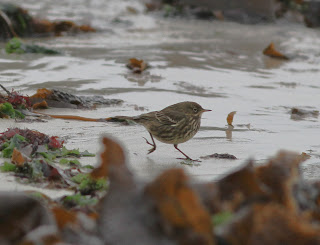... always a delightful area to visit and the small scale of this pristine estuary makes for easy birding ...
... a Greenshank fed along a tributary ...
... and a moulting juvenile Spotted Redshank was nearby ...
... feeding in typically frenetic style ...
... the plan to arrive on Fair Isle on Saturday 22nd September was foiled by high winds which meant that the Good Shepherd IV was not sailing ... we were on Shetland and going no further ... but Lerwick harbour looked attractive in the sunshine ...
... and had some small groups of Black Guillemot in various stages of moult into winter plumage ...
... the Shetland Starlings S.v.zetlandicus seemed to have a lot of character and to be vocally distinct from the nominate race ...
... a single Purple Sandpiper was on the rocks along with the many Turnstones ...
... and Gannets gave some nice views in the sheltered sound ...
... then news broke of a Yellow-breasted Bunting on Whalsay ... but too late in the day to arrange transport to that island ... luckily we were able to hire the last available car the following morning when the bunting was reported as being still present ... and just managing to squeeze onto the car ferry and drive up to the north of the island where the bunting had been doing feeding circuits around a series of ditches and fence lines ...
... after a rather tense half hour it was located in tussocky grass ... showing only intermittently ...
... but as often happens, a frustratingly skulky and flighty bird will eventually show well ... and so it did ...
The next morning allowed some time at Sumburgh Head where the Fulmars were riding on the wind ...
... and a Wheatear at Sumburgh Farm was one of the few visible migrants ...
... then the Good Shepherd made it across from Fair Isle and arrived at Sumburgh ...
... a couple of hours late in arriving and with a flock of sheep to unload from the hold, then the inevitable clean up followed by loading a whole array of provisions, a mobile generator and a sizable boat ... then we were under way ...
... birding was nigh on impossible from the boat which was rolling 30 degs consistently with occasional 45 deg rolls ... Fulmars and Gannets flashed by as we hung on ...
... and finally we arrived at the Observatory ...
It was a 07.00 start the next day with a trap round with Dave Parnaby ... the Heligoland traps yielded only about six birds ... with nothing more interesting than Twite ...
... but it was good to get a first real feel of the island ...
... the following day Richard Cope did the trap round and the catches were similarly unremarkable save for a group of Starlings not yet wise to the strategy of evasion ...
... another Twite is processed ...
... a Golden Plover flock frequented the high ground and flew around from time to time ...
... Bonxies were still present in dwindly numbers ahead of their departure ...
... after an influx of rarities and scarcities earlier in the month the island was, as the trap round had indicated, very quiet ...
... there were however a small number of Common Rosefinches on the island but with high winds persisting they were keeping low in the vegetation ... but eventually one perched on a fence for a few seconds before flying off into the distance ... a precious moment nevertheless !
... with thin pickings all around a Siskin gave some satisfaction as it clung briefly to a wire ...
... and likewise a Whinchat ...
... a Hooded Crow posed nicely ...
... and Rock Doves were never far away ...
... and Twite are always a joy, particularly in the absence of scarcer birds ...
... having heard some unseen Fair Isle Wrens calling from vegetation it was good to finally get some lovely views as these very distinctive birds foraged at the top of the beach ...
... while closer to the water three Ringed Plovers picked among the debris ...
... with their diminutive stature and dark mantles these were surely Tundra types ...
... and a Rock Pipit fed nearby ...
... on our planned day of departure the news was that the Good Shepherd was not venturing out ... maybe the plane would fly if there was a window between the early morning fog and the subsequent high winds that were forecast to follow ... we waited at the airstrip as the rain came down ... the fire engine arrived ... the wind sock went up ... and the plane jagged in ...
... a painless return to Shetland and then to Aberdeen ...
The nearby coast produced views of the many juvenile Gannets ...
... and a close in Red-throated Diver still in breeding plumage ...
... on the Don Estuary an argentatus Herring Gull loafed with the others ...
... and a Common Gull still in juvenile plumage must be a likely L.c.heinei (aka Russian Common Gull) ...
Loch of Strathbeg had large numbers of Pinkfeet and some Whooper Swans but was otherwise unremarkable but at Meikle Loch a Pectoral Sandpiper showed distantly to round off the day ...













































No comments:
Post a Comment